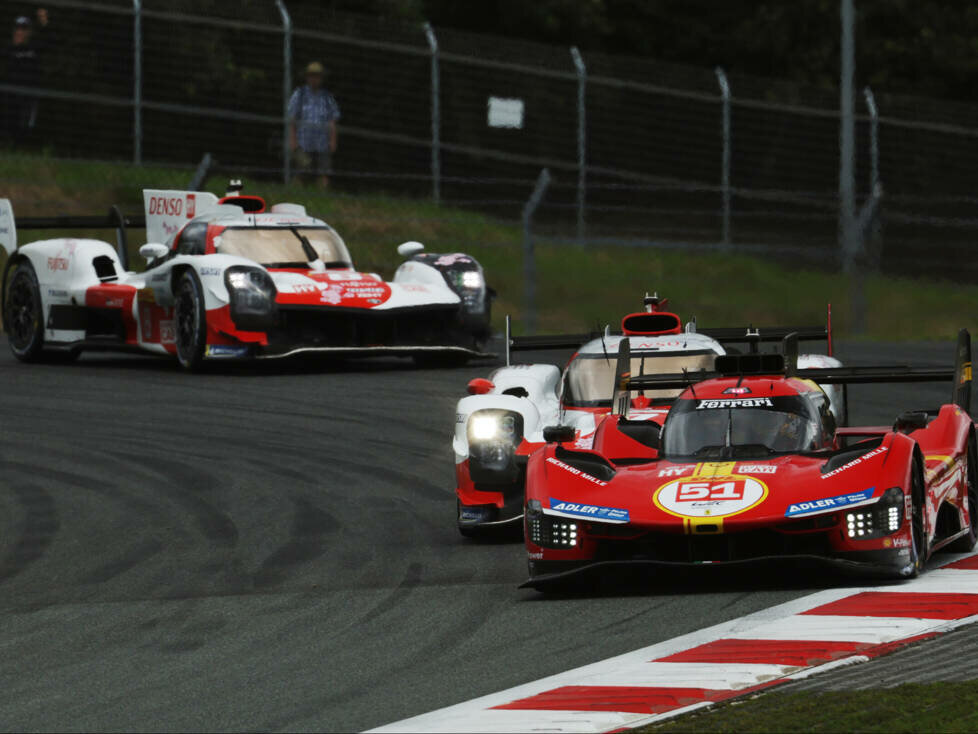The fact that Toyota ultimately finished well ahead of Ferrari at the 6 Hours of Fuji is due in no small part to track knowledge and experience, according to Pascal Vasselon and Kamui Kobayashi
While Toyota celebrated their early win of the manufacturer’s title in the 2023 World Endurance Championship (WEC) season with a double victory at the 6 Hours of Fuji last weekend, it was Ferrari’s weakest performance since they have been involved in the hypercar class.
In Fuji, the two Ferrari 499P cars, driven by Fuoco/Molina/Nielsen and Pier Guidi/Calado/Giovinazzi, finished one lap down in fourth and fifth place respectively. The final podium position behind the two Toyota GR010 Hybrids was taken by Porsche with Estre/Lotterer/Vanthoor.
The Toyota camp is of the opinion that Ferrari was slowed down in Fuji by the inconsistency of the drivers. This, in turn, was the result of comparatively little knowledge of the track. “If you look at the lap times, we are talking about one or two tenths of a second [between the manufacturers],” analyses Toyota technical director Pascal Vasselon.
“On the best 60 per cent of the laps we are within two tenths of a second of Porsche. And if you look at Ferrari, Fuoco was really competitive there, especially in the first stint,” said Vasselon, who concludes, “I think at Ferrari they probably have a little bit of a problem with the level of the drivers, because Fuoco was clearly competitive. I think we have the more consistent drivers. “
“Kamui effect” and more play into Toyota’s cards
According to Vasselon, however, Toyota not only have the more consistent drivers in their line-up than Ferrari. Especially at the home race in Fuji, the “Kamui effect” came into play, as the technical director explains with reference to Kamui Kobayashi.
In qualifying on Saturday, Kobayashi took pole by six tenths of a second. In Sunday’s race, he overtook the sister car (Buemi/Hartley/Hirakawa) in the final stint to secure victory for the 7 Toyota (Conway/Kobayashi/Lopez) by 39 seconds.
“I think it’s the special ‘Kamui effect’,” said Vasselon. “It’s obvious that he’s a step ahead of the other drivers here. It’s simply because he races here so much.” With that, the Toyota technical boss is alluding to Kobayashi’s dual WEC and Super Formula programme.
Also Ryo Hirakawa, one of the three drivers in the 7 Toyota.
Kobayashi, incidentally, shares Vasselon’s view that track knowledge played a crucial role at Fuji. “That was a race where the drivers had to change the car balance and the brake balance again and again to adjust their driving style in order to preserve the tyres,” explains the Japanese driver.
“From that point of view,” Kobayashi continues, “the key to the result was to adapt quickly. That’s where we have an advantage with our experience, because that’s what our drivers are capable of. It wasn’t like Ferrari was slow all the time. “
“They had some strong stints. Why? Because the drivers who could adapt were fast. With Toyota, any driver can do that. I just think it’s a product of all our years of experience,” said Kobayashi, who also holds the post of team president at Toyota in addition to his role as a driver.
Toyota also as good as through in the drivers’ world championship
And Ferrari? As far as the Italians are concerned, the race result of the 6h Fuji means that their chances of winning the drivers’ title in the 2023 WEC season are only theoretical. The gap between the Le Mans winners Pier Guidi/Calado/Giovinazzi and the championship leaders Buemi/Hartley/Hirakawa is now 31 points.
At the season finale, the 8h Bahrain on 4 November, 39 points will still be awarded. In purely mathematical terms, Fuoco/Molina/Nielsen in the other Ferrari still have a chance of winning the title. However, they are already 36 points behind.

